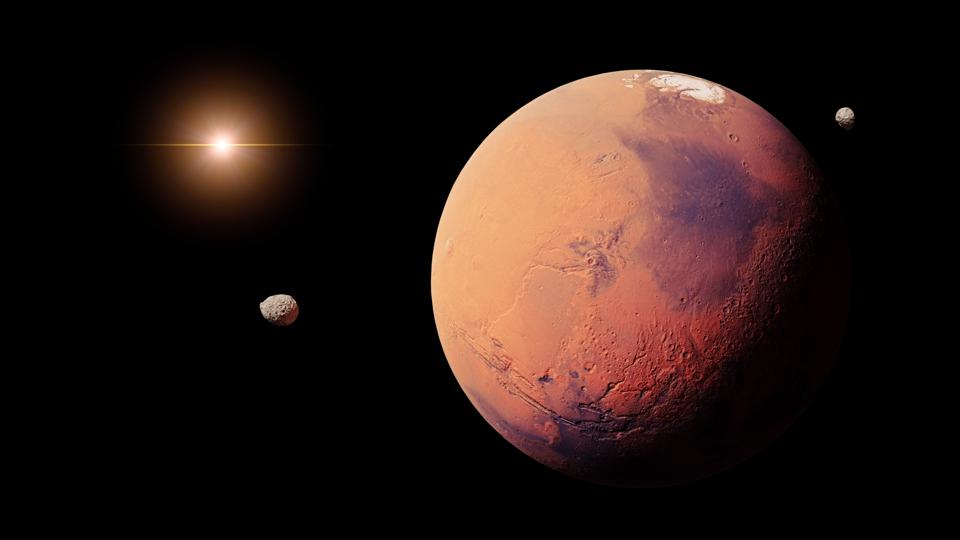Mars’ mysterious moons of Deimos and Phobos have long puzzled planetary scientists. For decades, it was thought that they were simply asteroids that had been gravitationally captured into Mars’ orbit.
But in the last decade or so, planetary theorists have warmed to the notion that the most likely scenario for the origin of both moons stems from a large Mars impactor creating a debris ring around the red planet from which both moons may have coalesced.
It’s also possible that Deimos and Phobos formed from the same disk of material that formed Mars itself, some 4.6 billion years ago.
Yet a new paper accepted for publication by The Planetary Science Journal confirms
that neither moon was gravitationally captured by Mars. Today, the moons orbit Mars at average distances that range from some 23,463 km for Deimos to only 9376 km for Phobos.
Even so, the authors are still puzzled over whether Phobos, in particular, formed early or late.
Phobos could have formed billions of years ago at more than twice its current distance from Mars, or it could have formed only 100 million years ago some 20 percent further away from Mars, Matija Cuk, the paper’s lead author and a planetary dynamicist at the SETI Institute in Mountain View, Calif., told me via email.
The Team’s Simulations Are Unique
We included “lumps” in Mars’ gravity field, and also the full gravity of the Sun, says Cuk. Our model also used direct numerical simulations, meaning that we modeled orbits from scratch and do not use time-saving approximations, he says.
Even so, the dominant hypothesis now is that they both may have formed from the aftermath of a large impactor that formed a debris disk around Mars, says Cuk.
As for their being captured asteroids?
Phobos and Deimos have orbits that are close to the Mars’ equator, indicating their formation from a circumplanetary disk, the authors write.
This means that they formed there and were not gravitationally captured by Mars, says Cuk.
Yet Phobos is particularly puzzling.
Phobos orbits faster than Mars spins, so it rises in the West and sets in the East, says Cuk. Because of this, Phobos’ own gravity causes a slight flexing of Mars’ surface which over time causes this Martian moon’s orbit to decay and move closer to the red planet’s surface, he says.
Question is: How long has Phobos been moving inward and from where and when did it form?
There are two distinct theories, one that Phobos formed relatively close to Deimos billions of years ago, and the other is that Mars has a repeating cycle of moons breaking into rings which then form new moons, says Cuk.
A Repetitive Cycle?
Phobos is now spiraling into Mars and will be gravitationally pulled apart by Mars’ gravity and within a few tens of millions of years, Phobos will become a ring of debris, says Cuk.
It’s a process that can repeat again and again. Each successive inspiralling moon will be torn apart which will result in the creation of a new ring of debris from which another moon will form. This would likely mean that Phobos and its predecessors were each relatively short lived.
This would explain why we appear to have caught Phobos in the final stages of its life, says Cuk.
The Bottom Line?
Just based on the current orbits of Phobos and Deimos, we cannot tell how old Phobos is and how much its orbit has changed over time, says Cuk. Deimos is almost certainly billions of years old, while Phobos is either more than four plus billion years old, or some 100 to 200 million years old, he says. Either scenario could be true, says Cuk.
As for which moon is most scientifically interesting?
I prefer Deimos, says Cuk. Unlike Phobos, it has not moved much, and Deimos’ orbital tilt may be the only evidence that Mars had other moons in the past, he says.
But as Cuk points out, we are likely to know more about Phobos first, since Japan is launching its Martian Moons eXploration mission in 2026. If successful, MMX will return a Phobos sample back to Earth potentially decades before NASA returns samples from Mars’ surface.

